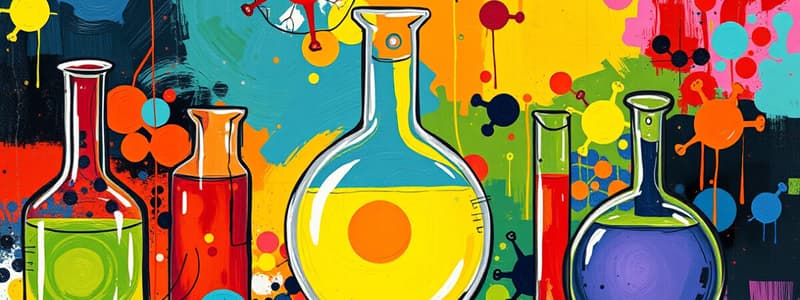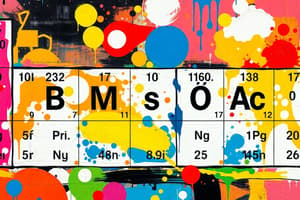Podcast
Questions and Answers
What is an element?
What is an element?
- A pure substance containing only one kind of atom (correct)
- A mixture of different substances
- A compound with multiple atoms
- None of the above
What defines a compound?
What defines a compound?
- Contains two or more kinds of atoms combined chemically (correct)
- A mixture that can be separated by physical means
- Made up of only one kind of atom
- Only contains gases
Which of the following is a mixture?
Which of the following is a mixture?
- Air (correct)
- Sugar (C6H12O6)
- Water (H2O)
- Diamond (C)
What is the definition of a mixture?
What is the definition of a mixture?
What is the formula for water?
What is the formula for water?
______ is a compound with the formula NH3.
______ is a compound with the formula NH3.
Match the following substances to their type:
Match the following substances to their type:
A compound can be separated by physical means.
A compound can be separated by physical means.
Krypton (K) is an element.
Krypton (K) is an element.
Which of the following is a compound?
Which of the following is a compound?
Which of the following are classified as mixtures?
Which of the following are classified as mixtures?
Flashcards are hidden until you start studying
Study Notes
Elements
- Pure substances containing only one kind of atom.
- Always homogeneous and cannot be separated into simpler materials except during nuclear reactions.
- Over 109 elements are classified on the periodic table.
- Examples include Diamond (C), Krypton (K), Bismuth (Bi), Uranium (U), Iron (Fe), Gold (Au), and Titanium (Ti).
Compounds
- Pure substances made of two or more kinds of atoms that are chemically combined.
- Always homogeneous and cannot be separated by physical means; requires a chemical reaction for separation.
- Properties of compounds differ from the properties of the individual elements they contain.
- Examples include Water (H2O), Ammonia (NH3), Dry Ice (CO2), Sugar (C6H12O6), Sulfuric Acid (H2SO4), Baking Soda (NaHCO3), and Alcohol (CH3OH).
Mixtures
- Composed of two or more elements or compounds that are not chemically combined, with no reaction occurring between substances.
- Can be homogeneous (solutions) or heterogeneous (non-uniform).
- Mixtures can be separated into components through physical or chemical means.
- Properties of mixtures reflect the properties of their components.
- Examples include Air, Wood, Bronze, Milk, Gasoline, Pails of Garbage, Ink, Popcorn, Dogs, Pizza, and Concrete.
Non-Classified
- Energy and Electricity do not fall into the categories of elements, compounds, or mixtures.
Studying That Suits You
Use AI to generate personalized quizzes and flashcards to suit your learning preferences.





